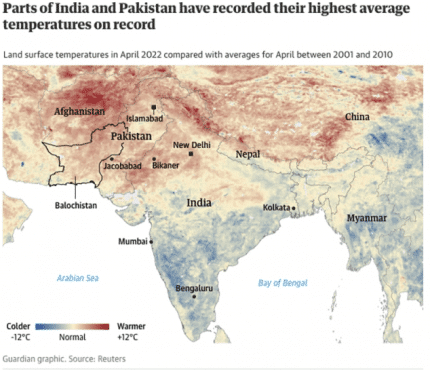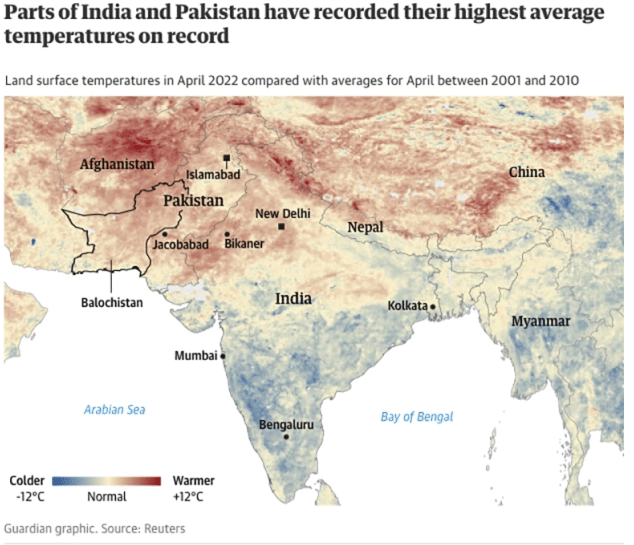

The relentless heatwave in Pakistan and India continued to climb this week, as more than one billion people experience temperatures of 5-8 degrees Celsius above normal. Already temperatures have broken a 122-year-old record high and threaten to cause more deadly heat-related illnesses. My home in the mountains of Himachal Pradesh, India has been warmer than usual as well. In March, the average day temperature hovered between 31 to 34 degrees celsius. This year, it has been the most affected by heatwaves, with 21 heatwave and severe heatwave days.
After the hottest March on records, preliminary data suggests April 2022 is the 4th hottest in Indian climatic history. In the Northern and Central regions, it’s the hottest ever. Waiting for the Pakistani data,where April, like March, will probably be confirmed as the hottest. https://t.co/bc3Ac2e3NE
— Extreme Temperatures Around The World (@extremetemps) April 30, 2022
Heatwaves in India are likely to “last 25 times longer by 2036-2065” if carbon emissions remain high and push global temperature rise to 4°C by the end of the century, according to an international climate report published in October 2021, covering the G20 countries.
The heatwave in India isn’t just about temperatures. The country is home to more than a billion people—almost a fifth of Earth’s population. Many of them are experiencing oppressive heat.
Here’s a quick map of cities scaled by population, colored by @NASA GEOS-5 air temps. pic.twitter.com/OumtKsuTvv
— Joshua Stevens (@jscarto) April 29, 2022
The truth behind these heatwaves is searingly clear: fossil fuels did this. While these temperatures are quite shocking, they come as no real surprise to communities that have long since lived on the frontlines of the climate crisis. This is the latest spike in a rapidly worsening disaster, one that was foretold by climate activists the world over. The IPCC report had already predicted that this densely populated region, where the vulnerabilities of over a billion people are compounded by power outages and lack of access to water, will be one of the worst affected by climate impacts- Namrata Chowdhary, Chief of Public Engagement at 350.org says
It is so hot that people in India resort to dark humor and ingenious methods to cope with the heat. In Sonepur, Odisha where temperatures touched 48° Celsius, one woman was able to cook Chapati on a car bonnet.
Scenes from my town Sonepur. It’s so hot that one can make roti on the car Bonnet
@NEWS7Odia #heatwaveinindia #Heatwave #Odisha pic.twitter.com/E2nwUwJ1Ub
— NILAMADHAB PANDA ନୀଳମାଧବ ପଣ୍ଡା (@nilamadhabpanda) April 25, 2022
In New Delhi, India, auto-rickshaw driver Mahendra Kumar has planted a garden on the roof of his rickshaw to beat the heat.
VIDEO: Delhi driver grows garden on auto-rickshaw roof to beat the heat.
Yellow and green auto-rickshaws are ubiquitous on New Delhi’s roads but Mahendra Kumar’s vehicle stands out — it has a garden on its roof aimed at keeping passengers cool during the searing summer season pic.twitter.com/9DIYv7lVR2
— AFP News Agency (@AFP) May 3, 2022
This is a Climate Crisis in South Asia
Nepal witnessed the hottest March and April on record. The average temperature in Kathmandu broke the heat record of the last 53 years. In Dharan, the temperature was 35.7°C in mid-March – another record. Now, the rising temperature has accelerated the melting of glaciers in the Himalayas. This is bad news for downstream communities as it increases the threat of flooding.
In Turbat, Pakistan, temperatures hit almost 50ºC, making it one of the hottest places on Earth. People were forced to stay indoors, unable to work during the day. Turbat’s 200,000 residents are left with no choice but to survive without electricity as the heatwave-surged energy demand left the city without electricity for almost nine hours every day. Heatwaves are also causing glaciers to melt in north Pakistan at an unprecedented rate, and thousands will be at risk due to any sudden cloud bursts.
#Pakistan soared up to a scorching 49C (120.2F) today.
That’s one of the hottest temperatures ever recorded on Earth in April. pic.twitter.com/AnIxNnjfwU
— US StormWatch (@US_Stormwatch) May 1, 2022
In Bangladesh, mild to moderate heat waves swept through the Khulna division and the districts of Faridpur, Madaripur, Gopalganj, Rangamati, Rajshahi, and Pabna.
Heatwaves are classified as one of the obvious impacts of climate change. The heatwaves currently sweeping across South Asia come at a critical time during the region’s wheat harvest. Farmers in the Indian state of Punjab are already foreseeing reduced crop yields. This comes at a time when India was hoping to boost wheat exports to make up for a shortfall in the global grain supply due to the war in Ukraine.
South Asia is on the frontline of the climate crisis and will experience devastatingly high temperatures if leaders do not take urgent action to lower carbon emissions. Therefore, immediate climate action and preventing heatwaves across South Asia should be a priority. The recent IPCC climate impacts report predicts frequent temperature extremes and heatwaves in Asia, especially in densely populated South Asian cities, where working conditions will be exacerbated, and daytime outdoor work will become dangerous. Much of South Asia could become uninhabitable if the rise in temperature continues, potentially leading to a large-scale humanitarian crisis.
The post Heatwaves in South Asia are a wakeup call to immediately limit greenhouse gas emissions everywhere appeared first on 350.org.


0 Commentaires